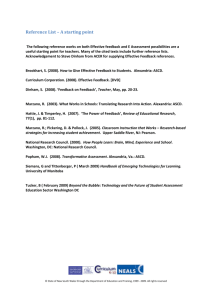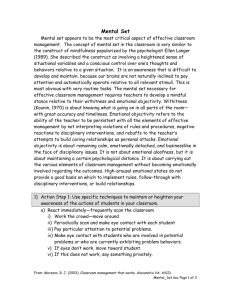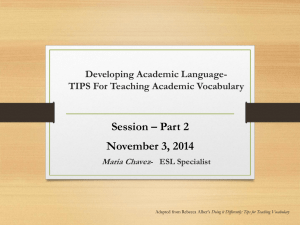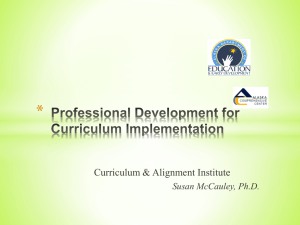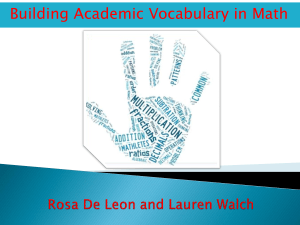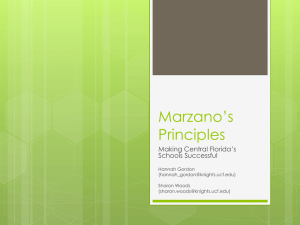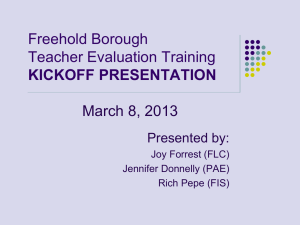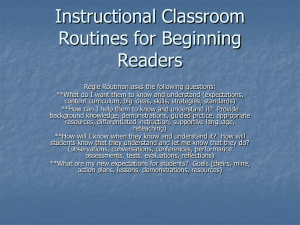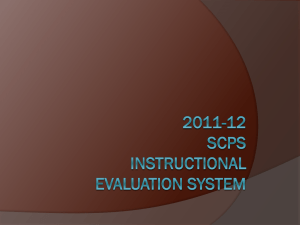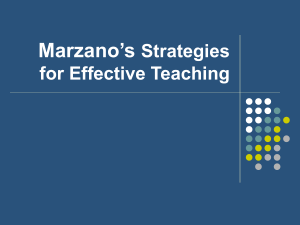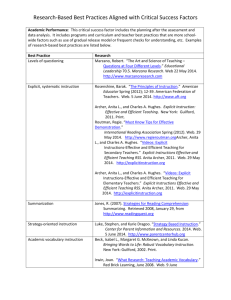Rules and Routines or Procedures
advertisement
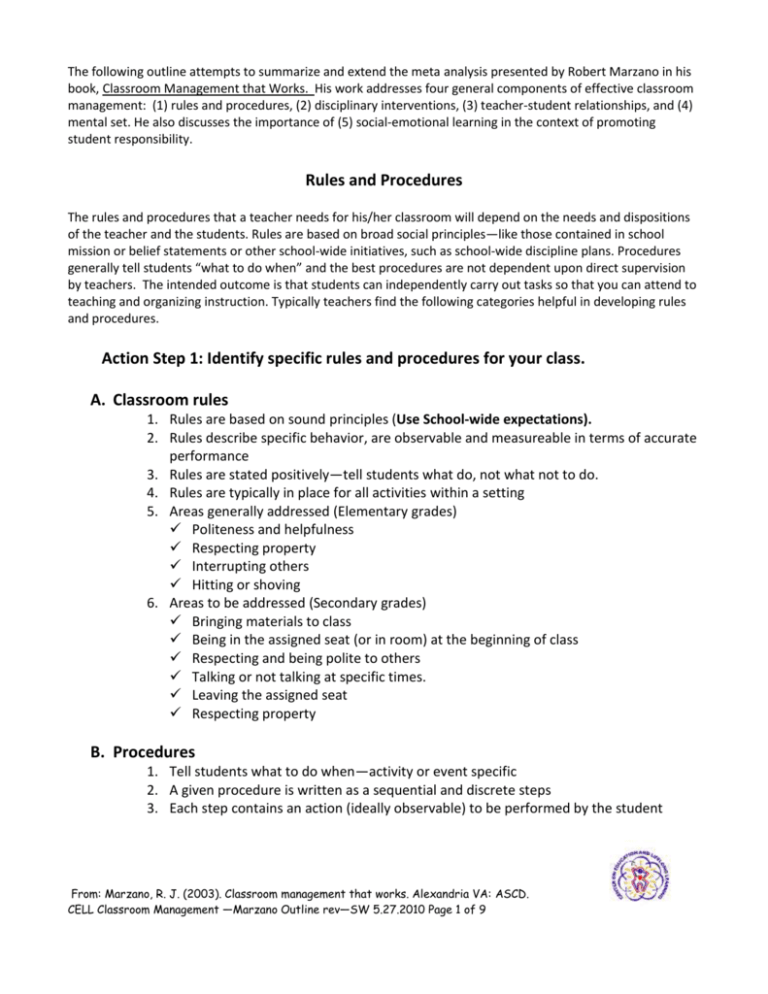
The following outline attempts to summarize and extend the meta analysis presented by Robert Marzano in his book, Classroom Management that Works. His work addresses four general components of effective classroom management: (1) rules and procedures, (2) disciplinary interventions, (3) teacher-student relationships, and (4) mental set. He also discusses the importance of (5) social-emotional learning in the context of promoting student responsibility. Rules and Procedures The rules and procedures that a teacher needs for his/her classroom will depend on the needs and dispositions of the teacher and the students. Rules are based on broad social principles—like those contained in school mission or belief statements or other school-wide initiatives, such as school-wide discipline plans. Procedures generally tell students “what to do when” and the best procedures are not dependent upon direct supervision by teachers. The intended outcome is that students can independently carry out tasks so that you can attend to teaching and organizing instruction. Typically teachers find the following categories helpful in developing rules and procedures. Action Step 1: Identify specific rules and procedures for your class. A. Classroom rules 1. Rules are based on sound principles (Use School-wide expectations). 2. Rules describe specific behavior, are observable and measureable in terms of accurate performance 3. Rules are stated positively—tell students what do, not what not to do. 4. Rules are typically in place for all activities within a setting 5. Areas generally addressed (Elementary grades) Politeness and helpfulness Respecting property Interrupting others Hitting or shoving 6. Areas to be addressed (Secondary grades) Bringing materials to class Being in the assigned seat (or in room) at the beginning of class Respecting and being polite to others Talking or not talking at specific times. Leaving the assigned seat Respecting property B. Procedures 1. Tell students what to do when—activity or event specific 2. A given procedure is written as a sequential and discrete steps 3. Each step contains an action (ideally observable) to be performed by the student From: Marzano, R. J. (2003). Classroom management that works. Alexandria VA: ASCD. CELL Classroom Management —Marzano Outline rev—SW 5.27.2010 Page 1 of 9 C. General Categories of Procedures 1. Arrival and Dismissal Areas to be addressed: Attendance at beginning of period, missed work the previous day because of absence, students who are tardy, ending period with clear expectations for homework and clean-up, signal for dismissal. 2. Transitions and interruptions Areas to be addressed: Arriving late with pass, leaving room, returning to room, drinks, restroom, leaving room for medicine, tutoring, classroom helpers, fire and other drills, going to office, nurse, etc. 3. Materials and equipment Areas to be addressed: Distributing materials, collecting materials, storage of personal and classroom materials, use of personal and classroom materials, heading papers, use of pencil sharpener, teacher’s desk area and storage areas. 4. Group work Areas to be addressed: Movement in and out of group, expected behaviors in group and not in group, roles and leadership, relationship of the group to the rest of the class, group communication w/ teacher, etc. 5. Seatwork and teacher led activities Areas to be addressed: Student attention during presentations, student participation, talking among students, obtaining help, movement in room, what to do when work is completed Action Step 2: Involve students in the design of rules and procedures. A. Effective management includes getting input, feedback and suggestions from the students. It is helpful to have a discussion of the purpose of rules and procedures and how they develop out of needs of the group. The following are some options for how you might facilitate student input into the rules and procedures. 1. Develop rules and procedures and solicit edits, suggestions, additions and deletions. 2. Develop some rules and procedures and offer some negotiable items. 3. Develop some rules and procedures and facilitate discussion of individual difficulties and needed supports. 4. Teacher develops rules and procedures for the students. Have students suggest rules specifically for the teacher. From: Marzano, R. J. (2003). Classroom management that works. Alexandria VA: ASCD. CELL Classroom Management —Marzano Outline rev—SW 5.27.2010 Page 2 of 9 Teacher--Student Relationship Moderate to high dominance is exemplified by clarity of purpose and strong guidance. Do not confuse dominance for dominance sake—it about leading with meaning. The guidance and purpose offered by the teacher should extend to both academic content and behavioral expectations of the school and classroom. Effective instruction that is meaningful and which facilitates high levels of student engagement with many opportunities and ways for students to actively participate demonstrates clarity of purpose and strong guidance. Clearly, these are positive characteristics. Extreme dominance can also be exemplified as a lack of attentiveness and neglect for the interest of students. Extreme submission (the other end of the continuum) is characterized by ambiguous purpose and weak or no guidance. Neither extreme defines the ideal teacher-student relationship. The same holds true for the second dimension—cooperation versus opposition. Moderate to high levels of cooperation are exemplified by a purposeful mindfulness of others’ needs and interests, and an aspiration to function as a member of a team. Again these are positive characteristics. But extreme cooperation is exemplified by an unwillingness or inability to act without the input and approval of others. Extreme opposition is exemplified by antagonism (overt or concealed) toward others and a wish to subvert their goals or desires. Again, neither end of the continuum results in a teacher to student relationship conducive to learning. It is the balanced combination of moderate to high levels of dominance (versus extreme dominance) and moderate to high levels of cooperation (versus extreme cooperation) that forms the ideal teacher attributes. Early in their careers teachers are more likely to exhibit behaviors characterized as highly cooperative, but because they generally have experienced limited opportunities to be in leadership roles, they are not very good at exhibiting behaviors that are highly dominant. Over time (between 6-10 years) they typically become come comfortable and quite accomplished at dominant behaviors and attitudes. The bad news is they also become less cooperative and more oppositional (Wubbels & Levly, 1993). 1) Action Step 1: Use specific techniques to establish a strong level of purpose and guidance a) Establish rules, procedures and disciplinary interventions Teach rules and procedures using a direct instruction model. b) Exhibit assertive behavior Body language—eye contact, erect posture, facing student but keeping unthreatening distance, matching facial expression with content of message Tone of voice—speak clearly, respectfully, deliberately, avoiding emotion in addressing inappropriate behavior. Persistence—persist until appropriate behavior is displayed, not ignoring inappropriate behavior, not being diverted by denying, arguing, blaming; but listening to and acting on legitimate concerns c) Model the behavior that you expect—at all times, but in particular when dealing with problem behavior. d) Establish Clear Learning Goals—Use rubrics frequently Communicate goals at beginning of unit Provide feedback on those goals—formative assessment Continually and systematically revisit the goals From: Marzano, R. J. (2003). Classroom management that works. Alexandria VA: ASCD. CELL Classroom Management —Marzano Outline rev—SW 5.27.2010 Page 3 of 9 e) Arrange the classroom to allow for close proximity to students and their work. f) Effective instruction Establish instructional match, considering the task and the student. Use visuals (many students are not auditory learners) Actively engage students in observable ways Structuring multiple ways for students to actively and frequently respond and participate Use 90% of allocated time for activity Frequently check for student understanding End activity by knowing how many students met the learning objective and involve students in self assessment End activity with specific feedback about academic and social performance Conclude the activity with specific information about what happens next Arrange for follow-up instruction/activity for students who were unsuccessful Know what you need to do the next time you do the activity. 2) Action Step 2: Use specific behaviors that communicate an appropriate level of cooperation a) Maintain a ratio of 4:1 positive to negative interactions. b) Provide flexible learning goals—solicit student input to add to goals: given your goals, what do they wish to learn/explore within the topic? c) Take a personal interest in students d) Be attentive (by scanning and moving) to all students and activities within the classroom. e) Use equitable and positive classroom behaviors Make eye contact with each student during visual scans, freely move within room Deliberately move and be close to each student. Arrange the physical space that allows for close proximity Positively interact with most students during lesson Attribute ownership of ideas during class discussions Allow and encourage participation and interactions by all. Provide appropriate wait time for all students regardless of history or perception of abilities. f) Respond appropriately to students’ incorrect responses Emphasize what was right or partially correct. Acknowledge approximations. Identify questions that fit the response Encourage collaboration. (think-pair share) Restate question and wait Rephrase questions and wait (but don’t be too wordy) Give guidance in the form of hints, clues, and scaffolds Provide answer and ask for elaboration or examples Respect options to pass when appropriate 3) Action Step 3: Be aware of student needs, temperaments and learning styles. From: Marzano, R. J. (2003). Classroom management that works. Alexandria VA: ASCD. CELL Classroom Management —Marzano Outline rev—SW 5.27.2010 Page 4 of 9 a) Notice behavior, observe outcomes, suggest assistance, formulate plans, follow-up, and evaluate. b) Assist students to know more about themselves. Plan lessons that allow students to work in preferred learning styles, intelligences, and encourage students to grow in nonpreferred styles. c) Accommodate temperament styles, acknowledge and support students when style does not fit well with tasks. There are some students who will require highly individualized accommodations-learning how to deal with aggressive, passive, hyperactive, inattentive, perfectionist and socially inept students. From: Marzano, R. J. (2003). Classroom management that works. Alexandria VA: ASCD. CELL Classroom Management —Marzano Outline rev—SW 5.27.2010 Page 5 of 9 Disciplinary Interventions Kathleen Cotton (1990) has estimated that discipline occupies about half of classroom time, with the other half remaining for instruction. Two primary goals for developing effective classroom management should be to increase time available for instruction and to reduce stress levels of teachers and students. Preventative activities like establishing clear guidelines for behavior, building community, and utilizing procedures to keep the operation of the classroom efficient can go a long way to reducing problem behavior. Acknowledging students who meet expectations send a clear message that we notice and appreciate student efforts, thereby encouraging students to meet the expectations. We also need to plan for interventions for rule infractions. It appears that how teachers deliver or assign reduction oriented consequences makes a huge difference in the effectiveness of consequences, including whether the consequence is perceived as punishing or helpful to student efforts to change. Further, we must overtly explore the possibility that our reduction-oriented consequences may, in fact, reinforce the very behavior we are trying to eliminate. The research shows that effective classroom managers utilize both reinforcement strategies and reduction- oriented consequences to encourage pro-social behavior. Action Step 1: Develop and use specific techniques that acknowledge and reinforce acceptable behaviors and acknowledge and provide reduction oriented consequences for rule violations. 5 categories of disciplinary interventions that can be used to provide a balance of positive and negative consequences: A) Teacher Reaction 1. Eye contact and proximity (never do with your mouth what your feet and eyes can accomplish) 2. Use a silent signal 3. Privately offer a reminder or an initiating request 4. If a student is simply off-task, but not disruptive, provide a prompt, stating the desired behavior 5. If a student doesn’t respond to these interventions, tell the student to stop the inappropriate behavior 6. Stimulus cueing. Provide a cue to the student before inappropriate behavior occurs. 7. Provide frequent physical signals and private acknowledgement for appropriate behavior. (When you accomplish this, simply withholding it is often an effective negative consequence) B) Tangible Recognition 1. Refers to any type of concrete recognition or reward offered by the teacher. C) Direct Cost 1. Strategies that involve an explicit and direct consequence for inappropriate student behavior 2. Token economies involve both tangible recognition and direct cost. From: Marzano, R. J. (2003). Classroom management that works. Alexandria VA: ASCD. CELL Classroom Management —Marzano Outline rev—SW 5.27.2010 Page 6 of 9 3. Time out—“chill chair” Removal from activity Removal from others Very short—purpose is to regain control Requires that students have a clear understanding of the behaviors that will lead to its use. May inadvertently reinforce behavior that is escape motivated. 4. Loss of privilege 5. Isolation time out Removal from room to a place reserved for disruptive students. Requires that students have a clear understanding of the behaviors that will lead to its use. May inadvertently reinforce behavior that is escape motivated. 6. Overcorrection Useful when student creates damage, loss or destruction Student is asked to overcompensate by making restitution. D) Group Contingency 1. Concrete recognition techniques that apply to a pre-established group of students. Interdependent—every student in the group must meet the established behavioral criterion for the group to earn credit Dependent—a specific individual or set of individuals must meet the criterion for the group to earn credit. Do not use group contingencies for negative consequences unless you wish to instill resentment, anger, and revenge E) Home Contingency 1. Most basic—informing parents of BOTH positive and negative behaviors of their children 2. More detailed—parents collaborate to establish a system of positive and negative consequences enacted at home. 3. Requires face to face meeting to establish behaviors and contingencies 4. Requires record keeping and communication Action Step 2: Be clear about limits for unacceptable behavior and an effective system to record these behaviors. A) Limits must be established, be realistic and meaningful B) Perfect opportunity to involve students in their own management C) Simpler record keeping formats are better D) Highly public record keeping runs the risk of detracting attention form the behavior to the record keeping. E) Involving students in their own record keeping is very effective for most students. From: Marzano, R. J. (2003). Classroom management that works. Alexandria VA: ASCD. CELL Classroom Management —Marzano Outline rev—SW 5.27.2010 Page 7 of 9 Mental Set Mental set appears to be the most critical aspect of effective classroom management. The concept of mental set in the classroom is very similar to the construct of mindfulness popularized by the psychologist Ellen Langer (1989). She described the construct as involving a heightened sense of situational variables and a conscious control over one’s thoughts and behaviors relative to a given situation. It is an awareness that is difficult to develop and maintain, because our brains are not naturally inclined to pay attention and automatically operate relative to all relevant stimuli. This is most obvious with very routine tasks. The mental set necessary for effective classroom management requires teachers to develop a mindful stance relative to their withitness and emotional objectivity. Withitness (Kounin, 1970) is about knowing what is going on in all parts of the room—with great accuracy and timeliness and letting students know that you know. Emotional objectivity refers to the ability of the teacher to be persistent with all the elements of effective management by not interpreting violations of rules and procedures, negative reactions to disciplinary interventions, and rebuffs to the teacher’s attempts to build caring relationships as personal attacks. Emotional objectivity is about remaining calm, emotionally detached, and businesslike in the face of disciplinary issues. It is not about emotional aloofness, but it is about maintaining a certain psychological distance. It is about carrying out the various elements of classroom management without becoming emotionally involved regarding the outcomes. High-arousal emotional states do not provide a good basis on which to implement rules, follow-through with disciplinary interventions, or build relationships. 1) Action Step 1: Use specific techniques to maintain or heighten your awareness of the actions of students in your classroom. 1. React immediately (but not quickly) to violations. Work the crowd—move around Periodically scan and make eye contact with each student Pay particular attention to potential problems. Make eye contact with students who are involved in potential problems or who are currently exhibiting problem behaviors. If eyes don’t work, move toward student. If this does not work, say something privately. 2. Forecast problems—identify potential difficulties and make plans to prevent or think about how you will intervene. Prevention is always better, do not “lay in wait.” 3. Observe a master teacher. 2) Action Step 2: Use specific techniques to maintain a healthy objectivity with students. 1. Squelch anger and frustration when delivering negative consequences. Do not be From: Marzano, R. J. (2003). Classroom management that works. Alexandria VA: ASCD. CELL Classroom Management —Marzano Outline rev—SW 5.27.2010 Page 8 of 9 sorry for enforcing rules by implementing consequences. One can express empathy for the student’s choice, but do not express that you are sorry for what you must do in response. 2. Look for reasons why and practice reframing--attribute best possible motives and partial positive outcomes. 3. Monitor your own thoughts. Do not hold grudges. Start fresh. Mentally review and anticipate problems with particular students. Try to replace negative expectations with positive ones. (Everyone will do something right.) When interacting with those students, think about your positive expectations. 4. Take care of yourself—deep breathing, guided imagery, sense of humor, seek opportunities to laugh, be your own best friend. References: Kounin, J. (1970) Discipline and group management in classrooms. New York: Holt, Rinehart, & Winston. Langer, E. J., (1989). Mindfulness. Reading, MA: Addison-Wessley. From: Marzano, R. J. (2003). Classroom management that works. Alexandria VA: ASCD. CELL Classroom Management —Marzano Outline rev—SW 5.27.2010 Page 9 of 9
